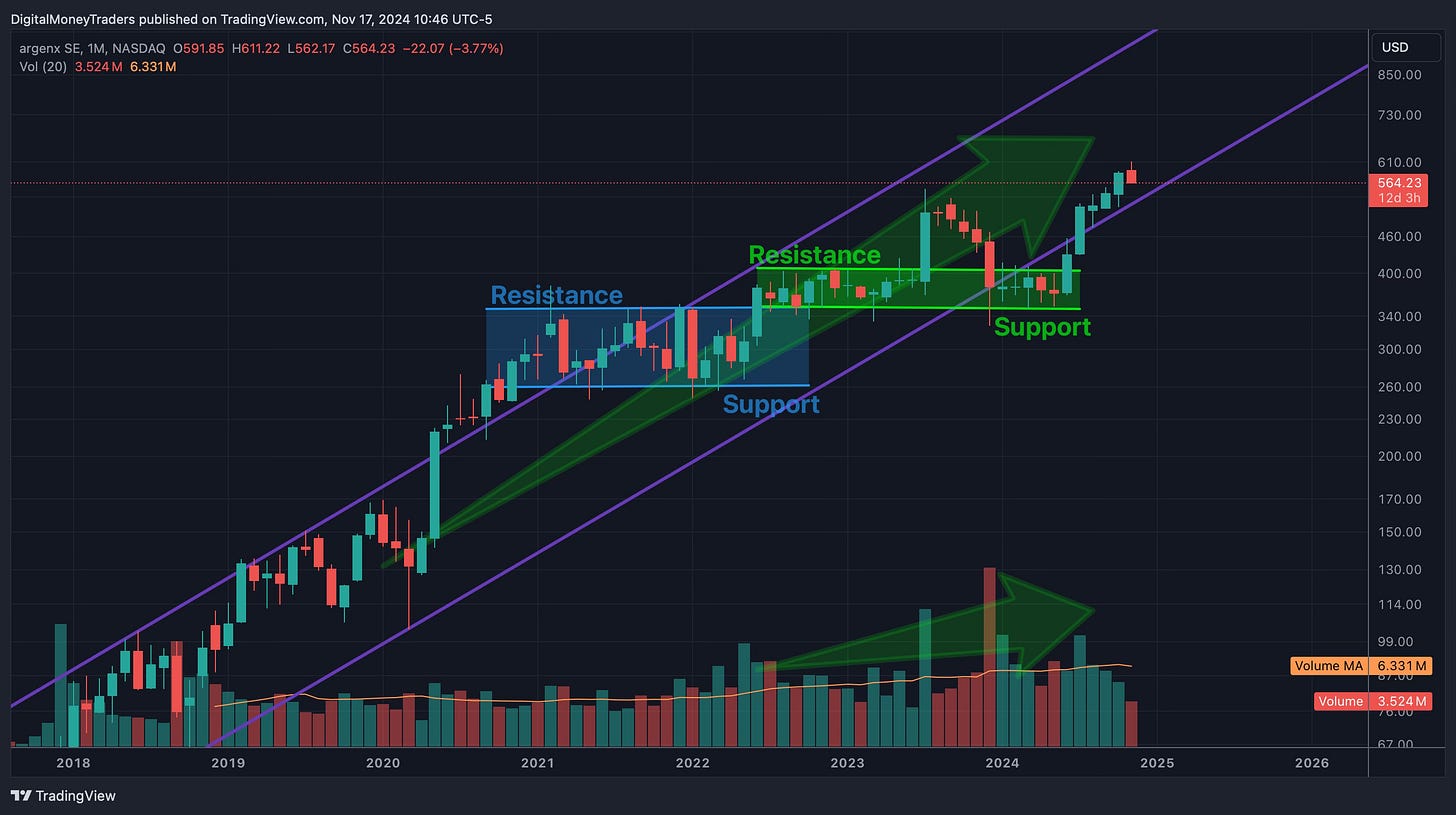IBB ETF WEEK WRAP-UP November 11 – November 15, 2024 NOTE: If you want to see the 11/18 – 11/22 IBB ETF forecast immediately, please jump down to the next section.
Last week’s hopeful start for the IBB ETF moving higher ended emphatically on Friday with the introduction of new political and regulatory uncertainty when President-elect Trump’s selection of Robert Kenedy, Jr., known for his anti-vaccine views, was chosen to run HHS. Further, he has been an outspoken proponent for disruptive change with respect to food and drug companies’ products and their regulation. The IBB ETF, after starting the week at $149.35 on the Monday open, trended down all week. The market reacted succinctly on Friday with the IBB ETF opening at $139.00, then closing the session down 4%, at $133.38, and down nearly 11% for the week.
New political and regulatory uncertainty has eclipsed hope of returning to a pre-IRA environment supportive of innovation, at least temporarily. That said, Johnson & Johnson (NYSE: JNJ) and Eli Lilly & Co. (NYSE: LLY) stepped up their defense of 340B plans when each filed lawsuits against the HRSA. The timing of these suits highlights the potential to return to decreased government price intervention in general, and more specifically via curtailing the IRA during the next Administration, in our opinion.
Price action is summarized in the IBB ETF charts below.
The IBB has conflicting signals and the trader should be on alert. Price action continues to consolidate and grind higher. Volume has not confirmed price action, and the All-Time High (ATH) had almost a full retracement. Price action did manage to hold a higher low after the ATH. The backbone of this setup is the bottom trend line. The bottom trend line, as known as rising support, has many touches making its relevance and strength more pronounced. Violation of this trend line would be confirmed with a close below plus 2-3% and/or 1-2 ATR.
The MACD and Histogram show consolidation. At the current time, MACD has no significant signal to act on.
The DMI indicates a weak trend.
On Monday, November 11th, argenx (NASDAQ: ARGX) and Zai Lab announced the approval of VYVGRAT Hytrulo for Chronic Inflammatory Demyelinating Polyneuropathy (CIPD) in China. This is the first treatment available for CIPD in China where there are approximately 50,000 patients diagnosed with the disease, many of whom do not respond to the current care of corticosteroids and plasma-derived therapies.
ARGX is showing strength and providing alpha despite the sideways moving IBB. The price action is holding the upward channel. Previous resistance is becoming support. Volume is confirming price action and the upward movement looks healthy.
The VRVP Visible Range Volume Profile shows the significance of the $375 price point. This is extremely strong support and should be now treated as the new floor for price action. The incorrect use of the arithmetic chart is for ease of VRVP interpretation as block size is based price ranges not percentages.
On a daily time frame the trend looks tired but not done yet. Notice previous MA50 and MA200 Bull Cross and the upward price action that followed. The RSI and price action diverting followed by a most recent gap down for cooling, forming a minor island reversal candle stick pattern. MACD had a divergence and bear cross along with the histogram anticipating the downward movement. There is no peak volume, no peak ADX, no euphoria. The trend does not seem over and should continue north after consolidation.
Last week, Vertex (NASDAQ: VRTX) presented on Tuesday November 12th at the Guggenheim Inaugural Healthcare Innovation Conference. Prior to the presentation, McKesson (NYSE: MCK) announced its InspiroGene business unit partnered with Vertex for expanded distribution of CASGEVY (exagamglogene autotemcel) for the treatment of sickle cell disease in patients with recurrent vaso-occlusive crises or transfusion-dependent beta-thalassemia (TDT). Recall, CASGEVY is the first FDA approved ex vivo CRISPR/Cas9 gene-edited cell therapy, which is also approved in the UK, EU and additional countries. This deal follows a long-term supply agreement announced in September 2024 with Lonza Group AG (NYSE: LZAGY) for CASGEVY manufacturing in its Netherlands facilities with plans to expand to the U.S. The Vertex roll-out of CASGEVY remains on track, according to the company, as Vertex continues to establish its clinical treatment facility infrastructure with 45 of the anticipated 75 centers up and running. See the Forecast section below for an analysis of the VRTX chart and more details.
Also, on Tuesday November 12th, Moderna (NASDAQ: MRNA) presented at the Guggenheim Inaugural Healthcare Innovation Conference. The company discussed its plans to rapidly buildout out their sales and marketing team, focusing on a few markets, to be effective, given the complexity of their anticipated growth plans. Moderna expects to submit three product candidates for approval in 2024 and annually thereafter for the next three years, totaling 10 filings. The company expects to expand its commercial presence into oncology and rare diseases with its future launches.
Additionally, Moderna presented again last week at the UBS Global Healthcare Conference on Wednesday November 13th. The focus at UBS was on the new political overhang which management considered more noise than real pushback, resulting from a desire for real data and transparency rather than a turn away from vaccinations. Moderna discussed 3Q24 again, highlighting the Covid and RSV vaccine markets’ size, share and guidance.
On Thursday, November 14, 2024, BioNTech (NASDAQ: BNTX) presented its Investor and Analyst Events Innovation Series R&D Day and kicked off the event on Wednesday with the announcement the company will acquire Biotheus. BioNTech will pay $800 million and up to $150 million in potential milestone payments. A significant portion of the Investor Day event was devoted to the acquisition, both in management’s presentation, as well as the Q&A.
The key take-away, in our view, is the acquisition will eliminate the company’s double digit royalty obligation and give BioNTech full rights and control of BNT327/PM8002, a PD-L1 x VEGF-A bispecific antibody that BioNTech believes could replace the checkpoint inhibitor standard of care treatments for solid tumors.
Last week, Gilead (NASDAQ: GILD) had multiple data presentations across its pipeline including lenacapavir and biktarvy in HIV and seladelpar to treat biliarycholangitis. At the International Congress on Drug Therapy in HIV Infection (HIV Glasgow 2024), positive results were reported from several clinical trials on November 12th and 13th . Results from the BICSTaR Study four-year study, which enrolled 2,379 people with HIV across 12 countries, showed long-term safety and efficacy of Biktarvy to treat HIV. Additional data presented and analysis of the GILD chart is discussed below in the Forecast section.
In the midst of reporting positive clinical trial data last week, Gilead priced its $3.5 billion offering of senior unsecured notes. Gilead announced pricing of the senior unsecured notes on November 13th in an underwritten, registered public offering, “consisting of $750 million of 4.80% senior notes maturing in 2029, $1 billion of 5.10% senior notes maturing in 2035, $1 billion of 5.50% senior notes maturing in 2054 and $750 million of 5.60% senior notes maturing in 2064”, according to the company. Closing of the offering is anticipated on or about November 20, 2024. The company plans to use the proceeds to repay debt and for general corporate purposes.
Despite the waft of positive data last week, GILD was unable to move against the downtrend last week and on Friday. GILD opened the week at $96.40 and closed on Friday at 88.4, down 8.3% for the week. The GILD chart is discussed below in the Forecast section.










